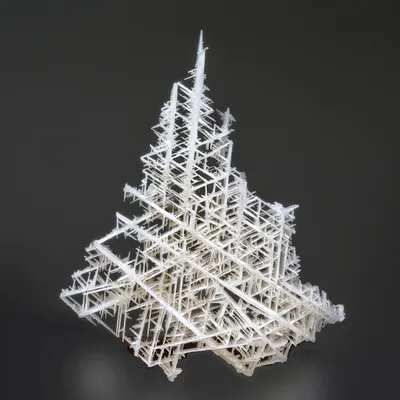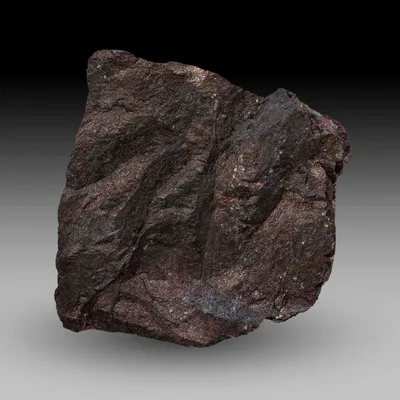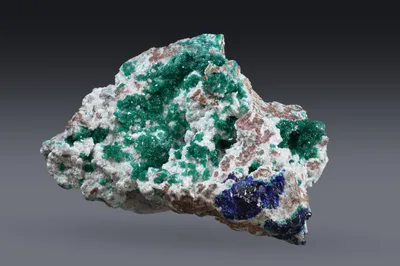Mineral Species
Pyromorphite
Type Locality
No
Composition
Pb5(PO4)3Cl
Crystal System
Hexagonal
Status at Tsumeb
Confirmed
Abundance
Extremely rare
Distribution
First and second oxidation zones
Paragenesis
Supergene
Entry Number
Species; TSNB293
General Notes
Pyromorphite was described as plentiful at Tsumeb by Schneider (1906) but two years later Maucher (1908a) considered it rare in comparison with mimetite. Almost certainly, Schneider (1906) and other early workers mistook mimetite dusted with microcrystalline duftite for pyromorphite.
Pufahl (1920) analysed several hundred mimetite specimens and found no phosphate, but a later spectrographic study of mimetite specimens in the Natural History Museum, London, found that a very few Tsumeb mimetites do have a moderate phosphate content (Mike Rumsey, pers. comm. to M. Southwood, October 2015).
Drescher (1926) was able to confirm pyromorphite from Tsumeb by spectrographic analysis, and Guillemin (1956) confirmed pyromorphite as tiny crystals on tsumebite by XRD analysis. The vintage of Drescher’s analysis and the paragenesis of Guillemin’s imply that both were conducted on specimens from the first oxidation zone, although it should be noted that XRD is not the most reliable method of distinguishing between pyromorphite and mimetite.
Klein (1938) considered pyromorphite very rare at Tsumeb, but noted the occurrence of poorly formed crystals, particularly at a depth of 190 m below the surface (7 Level). Klein’s collection catalogue (unpublished; Klein family archive) lists only one specimen of pyromorphite which Klein himself marked as questionable. The specimen (Klein #1001) is from 12 Level but unfortunately it cannot be traced.
Strunz et al. (1958a) and Strunz and Tennyson (1967) list pyromorphite as a mineral of the first oxidation zone with a simple note that it is "… very rare!" (Strunz et al. 1958a). Pyromorphite is not included in their lists of second oxidation zone minerals.
Geier (1973/1974) stated that "… to my knowledge it [pyromorphite] is not observed [in the second oxidation zone], but it has been reported from the upper oxidation zone".
Pinch and Wilson (1977) observed the following on pyromorphite at Tsumeb: "Forms relatively rare hexagonal needles and prisms up to 2 cm. The color ranges from colourless to green, brown, and bright yellow". This description, particularly the reference to 2 cm crystals, may indicate that these authors had also mistaken mimetite for pyromorphite. Still less convincingly, Weber (1977) in the same volume listed pseudomorphs of descloizite, tsumebite and vanadinite after pyromorphite. He provided Smithsonian Institution catalogue numbers for the tsumebite after pyromorphite (# 93854) and for the vanadinite after pyromorphite (#B13415) and cites "personal observation" for the descloizite after pyromorphite.
Gebhard (1999) noted that few "Tsumeb pyromorphites" have been verified analytically but that a single specimen with crystals to 5 mm was in the collection of Charles Key.
A specimen offered for auction by Joy Désor in 2019 included minute radiating sprays of pyromorphite with individual crystals to c. 45 µm., associated with galloplumbogummite, stolzite and a Ge-rich segnitite in an open vug in germanite-renierite ore. The pyromorphite was verified by Raman spectroscopy (www.e-rocks.com; accessed May 2019). The paragenesis strongly suggests that this is a second oxidation zone assemblage.
In 2020, Désor offered two more specimens for auction. The first consisted of intensely green pyromorphite crystals (c. 50 µm; EDS and Raman confirmed) associated with minute aggregates of pale green plumbogummite and brown wulfenite (www.e-rocks.com; accessed March 2020); the second comprised pale greenish-brown crystals of pyromorphite (SEM-EDS verified) on cerussite with a little molybdenite-rich sulphide matrix. Molybdenite was also EDS verified (www.e-rocks.com; accessed July 2020).
Associated Minerals
bianchite (?); cerussite; corkite; edwardsite; galloplumbogummite; germanite; gunningite; ktenasite; lauraniite; lazaridisite; libethenite; molybdenite; niedermayrite; renierite; segnitite; stolzite; tsumebite; wulfenite
Pseudomorphs
The following minerals are reported to form pseudomorphs after pyromorphite: descloizite (rare, doubtful validity); tsumebite (rare, doubtful validity); vanadinite (rare, doubtful validity).




